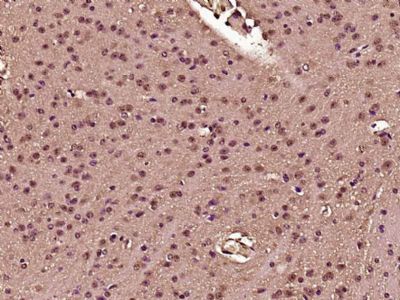PTBP2 Polyclonal Antibody
Purified Rabbit Polyclonal Antibody (Pab)
- 产品详情
- 实验流程
Application
| WB, IHC-P, IHC-F, IF, ICC, E |
|---|---|
| Primary Accession | Q9UKA9 |
| Reactivity | Rat, Dog, Bovine |
| Host | Rabbit |
| Clonality | Polyclonal |
| Calculated MW | 57491 Da |
| Physical State | Liquid |
| Immunogen | KLH conjugated synthetic peptide derived from human PTBP2 |
| Epitope Specificity | 21-120/531 |
| Isotype | IgG |
| Purity | affinity purified by Protein A |
| Buffer | 0.01M TBS (pH7.4) with 1% BSA, 0.02% Proclin300 and 50% Glycerol. |
| SUBCELLULAR LOCATION | Nuclear |
| SIMILARITY | Contains 4 RRM (RNA recognition motif) domains. |
| SUBUNIT | Monomer. Interacts with NOVA1; the interaction is direct. Interacts with NOVA2; the interaction is direct (By similarity). Identified in a mRNP complex, at least composed of DHX9, DDX3X, ELAVL1, HNRNPU, IGF2BP1, ILF3, PABPC1, PCBP2, PTBP2, STAU1, STAU2, SYNCRIP and YBX1. Part of a ternary complex containing KHSRP and HNRPH1. |
| Important Note | This product as supplied is intended for research use only, not for use in human, therapeutic or diagnostic applications. |
| Background Descriptions | PTBP-2 is a member of the polypyrimidine tract binding family of proteins. Predominantly expressed in brain, but also found in heart and skeletal muscle, PTBP-2 localizes to the nucleus and contains four RRM (RNA recognition motif) domains. PTBP-2 functions as an RNA-binding protein associated in a complex that is involved in the regulation of exon splicing and the stabilization of mRNAs in the cytoplasm. Six isoforms exist for PTBP-2 due to alternative splicing events. Isoforms 1 and 2 (also known as nPTB1 and nPTB2/PTBPLP-L, respectively) are neuronal-specific. Isoforms 3 and 4 (also known as nPTB3/PTBPLP-L and nPTB4, respectively) are found in non-neuronal tissues, as are isoforms 5 and 6 (also known as nPTB5/nPTB7/PTBPLP-S and nPTB6/nPTB8/PTBPLP-S, respectively). The existence of various isoforms may function to modulate the RNA-binding properties of PTBP-2 |
| Gene ID | 58155 |
|---|---|
| Other Names | Polypyrimidine tract-binding protein 2, Neural polypyrimidine tract-binding protein, Neurally-enriched homolog of PTB, PTB-like protein, PTBP2, NPTB, PTB, PTBLP |
| Target/Specificity | Mainly expressed in brain although also detected in other tissues like heart and skeletal muscle. Isoform 1 and isoform 2 are specifically expressed in neuronal tissues. Isoform 3 and isoform 4 are expressed in non-neuronal tissues. Isoform 5 and isoform 6 are truncated forms expressed in non-neuronal tissues. |
| Dilution | WB=1:1000-5000,IHC-P=1:100-500,IHC-F=1:100-500,ICC=1:100-500,IF=1:100-500,ELISA=1:5000-10000 |
| Format | 0.01M TBS(pH7.4) with 1% BSA, 0.09% (W/V) sodium azide and 50% Glyce |
| Storage | Store at -20 °C for one year. Avoid repeated freeze/thaw cycles. When reconstituted in sterile pH 7.4 0.01M PBS or diluent of antibody the antibody is stable for at least two weeks at 2-4 °C. |
| Name | PTBP2 (HGNC:17662) |
|---|---|
| Synonyms | NPTB, PTB, PTBLP |
| Function | RNA-binding protein which binds to intronic polypyrimidine tracts and mediates negative regulation of exons splicing. May antagonize in a tissue-specific manner the ability of NOVA1 to activate exon selection. In addition to its function in pre-mRNA splicing, plays also a role in the regulation of translation. |
| Cellular Location | Nucleus {ECO:0000250|UniProtKB:Q91Z31}. |
| Tissue Location | Mainly expressed in brain although also detected in other tissues like heart and skeletal muscle. Isoform 1 and isoform 2 are specifically expressed in neuronal tissues. Isoform 3 and isoform 4 are expressed in non-neuronal tissues. Isoform 5 and isoform 6 are truncated forms expressed in non-neuronal tissues |
Research Areas
For Research Use Only. Not For Use In Diagnostic Procedures.
Application Protocols
Provided below are standard protocols that you may find useful for product applications.
终于等到您。ABCEPTA(百远生物)抗体产品。
点击下方“我要评价 ”按钮提交您的反馈信息,您的反馈和评价是我们最宝贵的财富之一,
我们将在1-3个工作日内处理您的反馈信息。
如有疑问,联系:0512-88856768 tech-china@abcepta.com.
¥ 1,500.00
Cat# AP54674























 癌症的基本特征包括细胞增殖、血管生成、迁移、凋亡逃避机制和细胞永生等。找到癌症发生过程中这些通路的关键标记物和对应的抗体用于检测至关重要。
癌症的基本特征包括细胞增殖、血管生成、迁移、凋亡逃避机制和细胞永生等。找到癌症发生过程中这些通路的关键标记物和对应的抗体用于检测至关重要。 为您推荐一个泛素化位点预测神器——泛素化分析工具,可以为您的蛋白的泛素化位点作出预测和评分。
为您推荐一个泛素化位点预测神器——泛素化分析工具,可以为您的蛋白的泛素化位点作出预测和评分。 细胞自噬受体图形绘图工具为你的蛋白的细胞受体结合位点作出预测和评分,识别结合到自噬通路中的蛋白是非常重要的,便于让我们理解自噬在正常生理、病理过程中的作用,如发育、细胞分化、神经退化性疾病、压力条件下、感染和癌症。
细胞自噬受体图形绘图工具为你的蛋白的细胞受体结合位点作出预测和评分,识别结合到自噬通路中的蛋白是非常重要的,便于让我们理解自噬在正常生理、病理过程中的作用,如发育、细胞分化、神经退化性疾病、压力条件下、感染和癌症。






